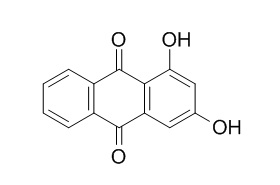Xanthopurpurin
Xanthopurpurin shows antiviral activity, it can effectively inhibit rotavirus multiplication by promoting virus-induced apoptosis in MA-104 cells. Xanthopurpurin shows mainly strong inhibition of collagen-induced platelet aggregation.
Inquire / Order:
manager@chemfaces.com
Technical Inquiries:
service@chemfaces.com
Tel:
+86-27-84237783
Fax:
+86-27-84254680
Address:
1 Building, No. 83, CheCheng Rd., Wuhan Economic and Technological Development Zone, Wuhan, Hubei 430056, PRC
Providing storage is as stated on the product vial and the vial is kept tightly sealed, the product can be stored for up to
24 months(2-8C).
Wherever possible, you should prepare and use solutions on the same day. However, if you need to make up stock solutions in advance, we recommend that you store the solution as aliquots in tightly sealed vials at -20C. Generally, these will be useable for up to two weeks. Before use, and prior to opening the vial we recommend that you allow your product to equilibrate to room temperature for at least 1 hour.
Need more advice on solubility, usage and handling? Please email to: service@chemfaces.com
The packaging of the product may have turned upside down during transportation, resulting in the natural compounds adhering to the neck or cap of the vial. take the vial out of its packaging and gently shake to let the compounds fall to the bottom of the vial. for liquid products, centrifuge at 200-500 RPM to gather the liquid at the bottom of the vial. try to avoid loss or contamination during handling.
Front Pharmacol.2021, 12:744624.
Sci Rep.2021, 11(1):10931.
Front Pharmacol.2021, 12:615157.
J Ethnopharmacol.2024, 333:118415.
J Appl Biol Chem2023, 66:455−461
Free Radic Biol Med.2021, 166:104-115.
Bull.Natl.Mus.Nat.Sci.,Ser.B.2024, 50(2):79ĘC86
Appl. Sci.2023, 13(2), 860.
Virus Res.2023, 335:199199.
Int J Mol Sci.2023, 24(3):2102.
Related and Featured Products
Front Pharmacol. 2016 Sep 13;7:308.
In vitro Antiviral Activity of Rubia cordifolia Aerial Part Extract against Rotavirus.[Pubmed:
27679574]
The root of Rubia cordifolia has been used traditionally as a hemostatic agent, while the aerial part of the plant consisting of leaf and stem is known to exhibit anti-diarrheal properties and has been widely used as a remedy in many parts of China. As rotavirus is one of the most commonly associated diarrhea-causing pathogen, this study aims to investigate the anti-rotaviral effect of R. cordifolia aerial part (RCAP).
METHODS AND RESULTS:
The cytotoxicity of RCAP toward MA-104 cells was evaluated using the WST-8 assay. Colloidal gold method and real time polymerase chain reaction (qPCR) assay were used to confirm the findings of the antiviral assay. Then, 4',6-diamidino-2-phenylindole (DAPI) staining method was subsequently used to investigate the mode of death among the cells. And the representative components of aqueous extract were isolated and identified. It was shown that both the viability of MA-104 cells and the viral load were reduced with increasing concentration of the extract. DAPI staining showed that virus-induced apoptosis was the cause of the low cell viability and viral load, an effect which was accelerated with incubation in the aqueous herbal extract. The major compounds postulated to exhibit this activity were isolated from the aqueous herbal extract and identified to be compounds Xanthopurpurin and Vanillic Acid.
CONCLUSIONS:
This study showed that RCAP extract effectively inhibited rotavirus multiplication by promoting virus-induced apoptosis in MA-104 cells.
J Nat Prod. 1994 Feb;57(2):313-6.
Antiplatelet constituents of formosan Rubia akane.[Pubmed:
8176404]
A known steroid, in addition to triterpenoids, anthraquinones, naphthalenes and a new anthraquinone glycoside, Xanthopurpurin 3-O-beta-D-glucoside, were isolated from the roots of Rubia akane grown in Taiwan.
METHODS AND RESULTS:
Mollugin, a naphthohydroquinone, showed strong inhibition of arachidonic acid (AA)-induced and collagen-induced platelet aggregation. In contrast, 2-methyl-1,3,6-trihydroxyl-9,10-anthraquinone, Xanthopurpurin 3-O-beta-D-glucoside, and Xanthopurpurin showed mainly strong inhibition of collagen-induced platelet aggregation.



